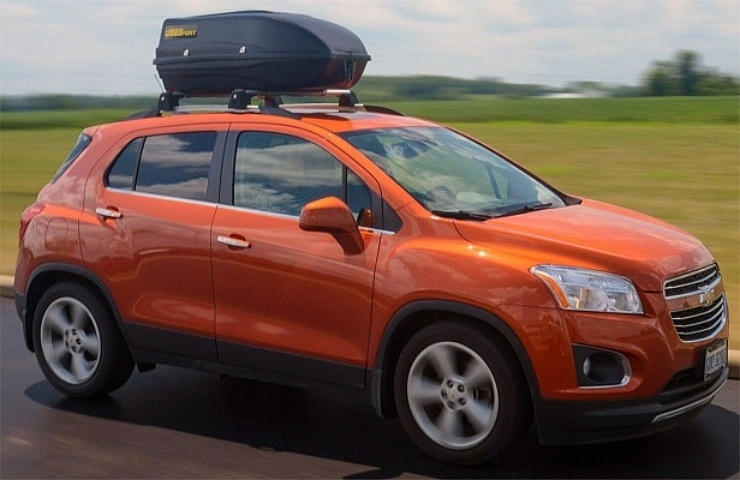Do you want to haul camp gear, skis, or other bulky items but there’s not enough room in your vehicle? It’s time to consider buying a vehicle rooftop cargo carrier or box.
Shop now for rooftop cargo carriers and boxes
Read about roof baskets and platforms, which are open storage solutions. They can provide a streamlined and flexible way to haul your gear. But they can’t be enclosed or locked.
What Will You Carry in Your Rooftop Cargo Carrier?

The affordable JEGS 90097 only holds 10 cubic feet and 110 pounds. But that might be exactly what you need.
Vehicle rooftop cargo carriers are typically hard-shelled but can also be available as soft-sided cargo haulers. Soft-sided containers are not quite as secure, but they have one key advantage. Soft haulers fold flat like an oversized duffle bag, so they can be more easily stored when not in use.

The quality and location of clasps is important for durability.
However, if you want to leave the rooftop cargo carrier in place, we suggest a hard-sided roof box. They usually can be opened either on one or both sides, depending on model.
Hard rooftop boxes and cargo carries are mounted to a vehicle’s factory or aftermarket crossbars via clamp-style attachments integrated into the bottom of a rooftop cargo box.
Rooftop cargo carriers can offer extras like interior tie-down points or luggage straps. It’s essential to secure your cargo within the box to prevent it from sliding around—even when come to a sudden stop.
Measure First and Then Match the Box to Your Needs
Rooftop cargo carriers are offered in many shapes and sizes. They can be big and boxy—or slim, skinny, and streamlined. So the first consideration is what you want to haul.
- Sets of skis? A long, slender skybox will fit the bill.
- Bulky backpacks and firewood? A taller, boxier design should suit you nicely.
- A big haul for a large family? Max out on the box size.

Choose a rooftop cargo container based on what you plan to store.
Containers are typically sized by cubic-foot ratings: the bigger the number, the more storage capacity. The smallest units are about 8 cubic feet. Large ones go as spacious as 25 or so cubic feet.
Each roof box for storage has a weight rating and maximum load capacity. Roof boxes may also give interior dimensions for cargo allowances.
- Measure what you want to stow before you buy any box.
- Confirm its interior dimensions to make sure it fits everything.
It’s also important to measure your garage’s height or carport’s roof before purchasing a car roof box. Your vehicle’s effective height could increase by a foot or more.
Tip: Check the roof box’s mounting instructions to make sure it’s compatible with your vehicle’s crossbars. Additionally, measure your vehicle’s roof length and width—as well as the crossbar spacing. The roof box will indicate the acceptable parameters.
Carrier Size: Small, Medium or Large?

The 14 cubic-foot cargo box from Goplus
We recommend that you consider a mid-size roof box or cargo carrier. A modestly-sized carrier will maintain a modern look to your vehicle. It can simultaneously provide oodles of storage opportunities and minimize drag and wind noise. You should expect that a rooftop cargo carrier will have an affect on fuel economy.
The Goplus roof box provides just 14 cubic feet. It’s a good mid-size cargo container.The Goplus roof box boasts 15 inches of height and is a bit skinnier and shorter than ski-carrying boxes. Saving inches equates to less weight: 25 pounds.

Thule XT XXL
Larger rooftop cargo carriers, like the versatile Thule Force XT XXL, are designed for a big set of everyday uses. Measuring at an exterior 90.5 x 35.5 x 18.5 inches, the Force XT XXL is long, wide, and can easily fit various belongings, including skis.
The choice comes down to overall storage capacity. The Thule Force XT XXL offers 22 cubic feet of capacity, whereas the Goplus roof box provides just 14 cubic feet.
Prices for rooftop cargo carriers range from a few hundred dollars to more than $1,000 for more robust systems. Spending more usually gets you more space and better durability. It also brings convenient features like strong locks and the ability to access your stuff from both sides.





